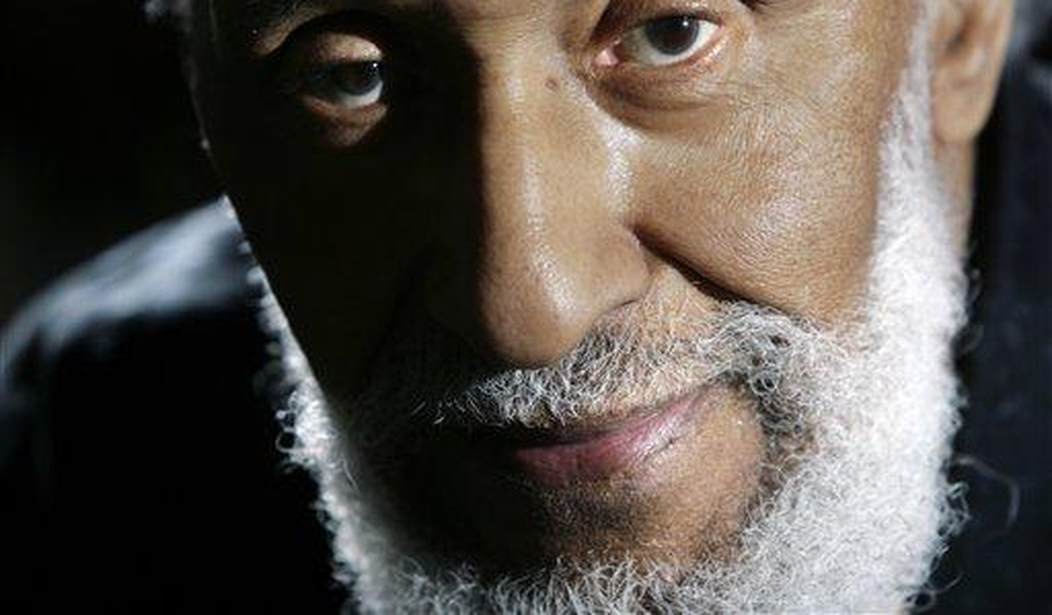Sonny Rollins was trending on Twitter Friday morning as he turned 93 on Thursday, and that’s a suitable occasion to recall and celebrate the man and his music. After all, America and its heritage are under attack from all directions these days, and that makes it incumbent upon patriots to recall a time when there was a great deal that united us not just politically but culturally and to work to bring those days back again. In his tenth decade, Sonny Rollins is a living exponent of those times and should be hailed accordingly.
Sonny Rollins is a tenor saxophonist and a titan of jazz, the quintessential American art form. He was still in his late teens when he burst upon the New York City jazz scene and quickly became the most sought-after tenor saxophonist in a hotly competitive field. Trumpeter Miles Davis wanted Rollins for his group; pianist Thelonious Monk wanted Rollins for his. A bit later, when asked to name his personal favorite among tenor saxophonists, the renowned tenor saxophonist John Coltrane immediately named Rollins, adding: “I think he’s the outstanding tenorman today.”
In 1956, Rollins recorded a towering masterpiece, “Saxophone Colossus,” which is on virtually every short list of the greatest jazz albums ever recorded. It’s a fine introduction to what jazz itself is all about, as Rollins kicks off with his own “St. Thomas,” a pleasing calypso melody that he states deftly before embarking upon an improvisation that is as inventive and thoughtfully constructed as the melody itself. That’s America in a nutshell: plan carefully, but also be able to think on your feet.
Rollins’ albums are filled with jazz workouts on classics from the Great American Songbook: Lerner and Loewe’s “I’ve Grown Accustomed to Her Face” on “Rollins Plays For Bird,” Al Jolson’s “Sonny Boy” on “Tour de Force,” Rodgers and Hammerstein’s “The Surrey With the Fringe On Top” on “Newk’s Time,” and innumerable others. It’s one American artist paying tribute to others by demonstrating the melodic strength of these old show tunes and showing what a master improviser can create from them.
Rollins made numerous other premier recordings, but like all great artists, was never satisfied with what he had attained. After completing a European tour in 1959 (Europeans have always appreciated this American art form more than Americans themselves have), Rollins retired from performing and recording for two years, only returning to the scene in Nov. 1961.
He did not, however, stop playing. Instead, Rollins began going out on the Williamsburg Bridge in lower Manhattan to practice and experiment with and perfect new approaches. Often he would be out on the bridge for fifteen or sixteen hours straight, developing his huge and rounded tone just to be heard over the traffic.
It’s a famous story in the jazz world: Sonny Rollins, conscious of the competition gaining on him, took some time off to work up some new techniques and rather than disturb the neighbors in his Manhattan apartment, took to the bridge to practice. But it’s much more than just an amusing and interesting detail. Rollins here demonstrates the truth of the old adage about genius being more a matter of perspiration than inspiration. Sonny Rollins was willing to practice fifteen or sixteen hours a day, outside in all kinds of weather, in order to remain at the top of his field.
In our age of entitlement and cultivated victimhood, it’s a useful lesson. You want to be celebrated? You want to be a hero? You could go the Dylan Mulvaney route of shallow exhibitionism and pander to the (malignant) spirit of the age, or you could just enhance your God-given talents with simple hard work. That’s the Sonny Rollins route. And up until quite recently, it was the American route.
Related: Giant of Avant-Garde Music Says: ‘If We Lose America, Shame on Us’
In these days when all the monuments are being torn down, it’s no surprise that many people have forgotten all about master musicians such as Sonny Rollins, if they ever knew. That makes it all the more important for all Americans to begin to shore some fragments against the ruins, and acquaint or reacquaint ourselves with all those who produced great art when political statements were not required (Sonny Rollins made those, also, but they weren’t even close to being the sole focus of his work), and when people of all races and backgrounds were free to appreciate the work of the great artists without being accused either of cultural appropriation or civilizational betrayal.
Put on some Sonny Rollins in celebration of his birthday. Start with the tracks that are linked above, but don’t stop there. This is your American heritage. Reclaim it.










Join the conversation as a VIP Member